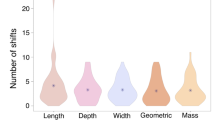Abstract
Fluctuating asymmetry (FA) in meristic characters is a random difference in count of a character between the right and left sides of an organism. Although FA has been used as an index of developmental instability for more than 30 years, it has not been closely related to the intensity of factors commonly thought to induce instability. The poor relationship could be due to use of biased FA metrics based on differences in bilateral counts, bias introduced by counting errors, low sample sizes, or a truly low correspondence between FA and stressor intensity. I demonstrate why FA metrics based on count differences are inherently biased for meristic characters, develop an unbiased maximum likelihood metric for FA (\(\hat \sigma _A \)), and establish a general method to remove bias caused by counting errors. A likelihood ratio test based on the new metric is nearly as powerful as the F-test, and has a Type I statistical error closer to the nominal level. When applied to bilateral counts of sternopleural bristles in Drosophila, the new metric confirmed previous results based on count differences but removed the concern that the FA estimates were biased by the character mean. Apparent differences in pectoral fin ray FA between rainbow and cutthroat trout disappeared after correction for counting errors.
Similar content being viewed by others
References
Björkland, M., and Merilä, J. (1997), “Why Some Measures of Fluctuating Asymmetry are so Sensitive to Measurement Error,” Annales Zoologica Fennici, 34, 133–137.
Falconer, D. S. (1981), Introduction to Quantitative Genetics (2nd ed.), London: Longman.
Hilborn, R., and Mangel, M. (1997), The Ecological Detective, Princeton, NJ: Princeton University Press.
Houle, D. (2000), “A Simple Model of the Relationship Between Asymmetry and Developmental Stability,” Journal of Evolutionary Biology, 13, 720–730.
Hubert, W. A., and Alexander, C. B. (1995), “Observer Variation in Counts of Meristic Traits Affects Fluctuating Asymmetry,” North American Journal of Fisheries Management, 15, 156–158.
Kristensen, T. N., Pertoldi, C., Andersen, D. H., and Loeschcke, V. (2003), “The Use of Fluctuating Asymmetry and Phenotypic Variability as Indicators of Developmental Instability: A Test of a New Method Employing Clonal Organisms and High Temperature Stress,” Evolutionary Ecology Research, 5, 53–68.
Mood, A. M., Graybill, F. A., and Boes, D. C. (1974), Introduction to the Theory of Statistics (3rd ed.), New York: McGraw-Hill.
Palmer, A. R. (1994), “Fluctuating Asymmetry Analyses: A Primer,” in Developmental Instability: Its Origins and Evolutionary Implications, ed. T. A. Markow, Dordrecht, Netherlands: Kluwer, pp. 335–364.
Palmer, A. R., and Strobeck, C. (1992), “Fluctuating Asymmetry as a Measure of Developmental Stability: Implications of Non-normal Distributions and Power of Statistical Tests,” Acta Zoologica Fennica, 191: 55–70.
— (2003), “Fluctuating Asymmetry Analyses Revisited,” in Developmental Instability (DI): Causes and Consequences, ed. M. Polak, New York: Oxford University Press, pp. 279–319.
Polak, M., and Starmer, W. T. (2001), “The Quantitative Genetics of Fluctuating Asymmetry,” Evolution, 55, 498–511.
Swain, M. W. (1987), “A Problem With the Use of Meristic Characters to Estimate Developmental Stability,” The American Naturalist, 129, 761–768.
Van Dongen, S. (1999), “Accuracy and Power in the Statistical Analysis of Fluctuating Asymmetry: Effects of Between-Individual Heterogeneity in Developmental Instability,” Annales Zoologica Fennici, 36, 45–52.
— (2000), “Unbiased Estimation of Individual Asymmetry,” Journal of Evolutionary Biology, 13, 107–112.
Van Dongen, S., Molenberghs, G., and Matthysen, E. (1999), “The Statistical Analysis of Fluctuating Asymmetry: REML Estimation of a Mixed Regression Modelm,” Journal of Evolutionary Biology, 12, 94–102.
Van Valen, L. (1962), “A Study of Fluctuating Asymmetry,” Evolution, 16, 125–142.
Weiner, J. G., and Rago, P. J. (1987), “A Test of Fluctuating Asymmetry in Bluegills (Lepomis macrochirus Rafinesque) as a Measure of pH-Related Stress,” Environmental Pollution, 44, 27–36.
Author information
Authors and Affiliations
Corresponding author
Rights and permissions
About this article
Cite this article
Young, J.R. Removing bias for fluctuating asymmetry in meristic characters. JABES 12, 485–497 (2007). https://doi.org/10.1198/108571107X249186
Received:
Revised:
Issue Date:
DOI: https://doi.org/10.1198/108571107X249186




